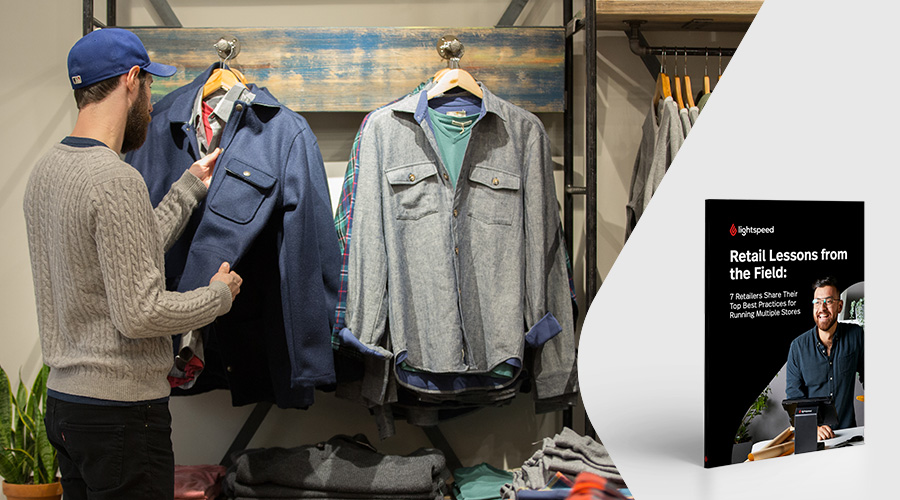
When one of your locations receives a new shipment from a wholesaler, how do you decide the prices of the inventory inside? Knowing how to price wholesale inventory for your customers is a challenge for even experienced retailers, but there are certain criteria that can help you price products so they sell.
“The goal is to price your product high enough where you can make a decent profit,“ says successful boutique owner Alli Schultz. “Yet not too high where it’s going to scare away all of your customers.”
As Schultz explains, there are a few strategies you can use that will help you know how to price your wholesale inventory so it sells. Let’s take a high-level look at the most common ones.
In this post, we’ll cover:
- How is wholesale inventory priced?
- 5 wholesale inventory pricing methods
- How to decide on a wholesale pricing strategy
Retailers Reveal Their Top Best Practices for Running Multiple Stores
We caught up with seven multi-store retailers and asked them to share their top best practices for running multiple locations.

How is wholesale inventory priced?
Wholesale inventory is inventory that retailers purchase from wholesalers (aka publishers or manufacturers) and then sell in order to make a profit. The manufacturer’s suggested retail price (MSRP) or recommended retail price (RRP) is set by the wholesalers, who sell their inventory to the retail store for around 50% of the RRP. The retailer (that’s you) then marks up the inventory accordingly and sells it to make a profit.
After buying your inventory, there are a variety of pricing strategies you can use to determine product pricing for retail, including keystone pricing, cost-based pricing, bundle pricing, loss-leading pricing and competition pricing.
5 wholesale inventory pricing strategies
1. Keystone pricing
Keystone pricing is the rule of thumb for retail and often the goal. It’s achieved by taking the wholesale cost per unit from your distributors and doubling it to reach the retail price. So if a shirt cost $4 to buy from the manufacturer, you would then use a 100% markup percentage and sell it for $8 in your store.
Pros of keystone pricing
The benefit of the keystone pricing method is that the suggested retail price provides a nice round number around which to calculate your profit margin. You never have to guess what a product will be priced at, no matter the variation in type or manufacturing quality, because it’s always double the wholesale price. That has the potential to save time for your teams.
Cons of keystone pricing
The downside is that this price isn’t always feasible, and it doesn’t factor in variables like the cost of running retail stores in different regions. Some customers may not be willing to pay such a high markup on goods they perceive as lower quality, and this strategy doesn’t set your business up to respond to fluctuating demand.
2. Cost-based pricing
Keystone pricing is one example of a cost-based pricing method, which is choosing a price that results in a profit margin high enough to cover your fixed and variable costs of doing business: your rent, your electricity, the hourly rate you pay your employees, etc. Unlike keystone pricing, other types of cost-based pricing will have higher or lower markups than 100%.
This method is primarily based on your individual business costs and based less on what your retail competition is charging.
Pros of cost-based pricing
With slightly more flexibility than keystone pricing, a general cost-based pricing strategy allows your business to still recoup costs while potentially offering a lower price to customers. Or, on the other hand, you could charge a higher markup and compensate customers with better services.
Cons of cost-based pricing
With this wholesale inventory pricing strategy, you might not make as large a profit as if you were marking up 100% across the board. Your financial experts will need to re-evaluate your markup at least annually to ensure you’re still covering your costs effectively, which adds extra admin time that keystone pricing doesn’t have.
3. Bundle pricing
Bundle pricing is an appropriate method for certain industries. In fact, a la carte pricing generally gives the advantage to the buyer, and bundle pricing favors the seller (that’s you), so you may want to experiment with this strategy.
Unbundled pricing is generally more transparent. But when you bundle your complementary stock and sell items together as packages, you are providing quality customer service, and often a bundle is perceived as a discount by the customer. This strategy is common among service providers (you probably bought a cable bundle) but with a little creativity, bundle pricing can be applied to any market.
Pros of bundle pricing
Like we said, bundles are often perceived as a discount by customers (and if you’re bundling products and/or services they see as valuable, their perception isn’t exactly wrong). That means in addition to being profitable for you, they can increase brand affinity, which is key to customer loyalty.
Cons of bundle pricing
Bundle pricing isn’t a one and done affair. Every product and/or service you want to bundle needs to have its own margin and sales strategy set, which is a lot of admin time for multiple teams. Unless you only sell a few products, you’ll probably want to use bundle pricing for your flagship offerings and use other wholesale pricing strategies elsewhere.
4. Loss-leading pricing
Did you know that Amazon loses money on every Kindle they sell? However, the gadgets drew customers to Amazon as it amped up its online store, and continue to serve as a gateway for ebook purchases. In the end, even though each Kindle costs more to make than its retail price, the boost the product provides to Amazon’s bottom line justifies the negative profit margin.
This is an example of loss-leading pricing. This aggressive method is often used to beat a competitor at their own game, and only works if you have a very robust market and pricing strategy in place.
Pros of loss-leading pricing
This pricing strategy can establish your business as the key player in your niche—the one with the must-have product that customers can’t get elsewhere without paying a lot more. It has the potential to bring in shoppers who go on to become repeat, loyal customers once they’ve got their initial foot in the door, a step they may not have taken otherwise.
Cons of loss-leading pricing
Loss-leading pricing is a risky strategy. If customers don’t bite in large enough numbers, you’ll just be losing money. If you are successful, but ever want to move away from loss-leading pricing, customers may be upset and move to a competitor (either someone established or a new disruptor in your space).
5. Competition pricing
This is exactly what it sounds like. Competition pricing strategy bases price around what the competition is choosing. It’s often used for key products by grocers (you don’t want to charge more for milk than the store down the street).

Pros of competition pricing
Competition pricing places your business in direct competition with other retailers—and for price conscious shoppers, that’s a good thing. It helps you remain in the running when potential customers do price comparisons without needing to cut margins too deeply (hopefully).
Cons of competition pricing
This pricing strategy can be hard to follow consistently for every product you sell. Your business has the potential to end up in an arms race with a competitor also using this pricing strategy, eliminating any gains you might make by reducing margins more and more.
How to calculate your wholesale price strategy
How do you know which pricing model is best for your company? With a little research. These variables are collectively known as value perception, and it’s where the art of pricing comes in. If you price your stock on math alone, you’re losing out on profits derived from the quirks of human nature.
Here are some basic steps for determining your wholesale pricing.
How valuable are your products?
Customers tend to spend more on certain types of products, like outerwear, so you can mark those up more than, say, a t-shirt. If you’re selling a name-brand product, you can generally charge more than you can for its generic equivalent.
Where are your locations?
Your store locations also matter. If you’re based in areas with lots of tourists, those customers may be willing to spend more than locals. A store in a high-income area like Beverly Hills is able to charge more for a product than the same type of store in a small Texas town.
What are the market conditions?
Is your industry thriving right now, or are sales slow? How are direct competitors picking their pricing methods? Where does your brand fall in the value perception scale?
A bundle pricing strategy might not work for a luxury retailer—those customers typically care much less about discounts. Is that your market niche? Try something else instead.
What is the cost of goods sold?
You don’t want to set prices that leave your business with barely any profit once COGS comes into consideration. In this sense, nearly all pricing strategies except loss-leading are cost based pricing!
Is there a MSRP or list price?
Some products have manufacturer suggested retail prices. While you can sell goods for under their MSRP, you’ll be making less profit. Also, other retailers might beat you out if you try to sell it over.
Software can help
Pricing wholesale inventory can be hard, but the right point of sale (POS) software can help. A robust POS like Lightspeed gives you automatic insights about which products are (and aren’t) selling in your store, so you can adjust your price level accordingly.
Your POS should automate your inventory management so you have a perfect view of your merchandise situation. Then you can analyze your own sales data and develop a unique pricing strategy that works for you.
Now that you know how to price wholesale inventory, it’s time to get to work. Watch a demo to learn how Lightspeed Retail POS can help your entire team manage every part of your business, while saving time and effort in the process.

News you care about. Tips you can use.
Everything your business needs to grow, delivered straight to your inbox.



![11 Tips To Make Your Pop-Up Shop a Roaring Success [For Retail Store Beginners and Pros Alike]](https://blog-assets.lightspeedhq.com/img/2021/06/2da3ae10-blog-hero_pop-up-shop.jpg)